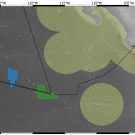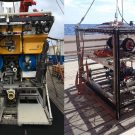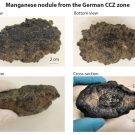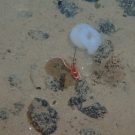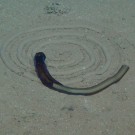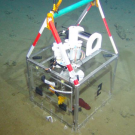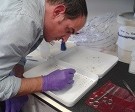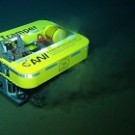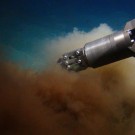Working areas and sampling sites during cruise SO268 of RV SONNE by Timm Schoening (GEOMAR) and Peter Urban (GEOMAR) RV SONNE cruise SO268-2 followed in the footsteps of the first leg of this expedition – SO268-1. We continue to sample the diverse seafloor in two main working areas within the Clarion-Clipperton-Zone (North-East Pacific). Our scope […]
Glimpsing through the eyes of deep-sea cameras/Ein Blick durch die Linse von Tiefsee-Kameras
– The Ocean Floor Observation System (OFOS) and Remotely Operated Vehicle (ROV) – (deutscher Text siehe unten) Many samples that marine biologists gather during research cruises are taken “physically”, such as deep-sea mud that is heaved up from the seafloor onto the deck via different coring gears, and gets further processed in the labs. With […]
Schätze der Tiefsee / Treasures of the Deep
(English below) Manganknollen – Entstehung und wirtschaftliche Relevanz von Jessica Volz, Sophie Paul und Julia M. Otte Während der ersten globalen Forschungsexpedition der HMS Challenger in den 1870er Jahren wurde das große Ressourcenpotential der Tiefsee deutlich. An Bord der HMS Challenger wurden zahlreiche unbekannte marine Organismen sowie mineralische Konkretionen vom pazifischen und atlantischen Meeresboden, die […]
SO268: What’s up on the seabed?
At the bottom of the Ocean, in ~4000m water depth they can be found in high abundances: Manganese nodules. Industry and states are interested in these potato-sized objects as a new metal resource. But before commercial mining will start, the potential ecological impacts need to be investigated. Therefore, the project MiningImpact (funded through JPI Oceans) […]
Traces of life
Antje Boetius, Autun Purser, Yann Marcon During this 4-week expedition we have been very busy with studying traces of human activity at depth on scales of centimeters to kilometers. There was so much to be learned from this study site at 4150 m water depth. But it is important to remember that the ploughing […]
CUBEs – Why do we place ‘mini’-houses on the seafloor?
It may not always be easy to see, but the deep seafloor is teeming with life! Microbes and worms live inside the sediment and large sea cucumbers crawl over the sediment. This life will probably be heavily disturbed if the industry gets permission to collect manganese nodules and remove or plough through the top layer […]
Testing new technology: Underwater Hyperspectral Imager
Being able to test brand new technology is always exciting. The Ecotone Scientific UHI (Underwater Hyperspectral Imager) brought from NTNU in Norway was finished only a week before the Sonne disembarked from Guayaquil. It is the first UHI to be designed for deep sea use (6000m). Any untested equipment will present some initial challenges. During […]
“Why are you doing this research?” – Questions of the International School in Bremen
Questions from a school class A number of the scientists and crew taking part in SO242-2 are based in Bremen, Germany. We have received a number of interesting questions from year 6 students attending the International School Bremen, sent to us by their teacher, Martyn Robinson-Slater. We in this blog will try and answer some […]
What lives, breathes – New technology to measure respiration in the deep sea
Today we present the benthic crawler “Tramper” and it first steps at the seafloor in 4150m water depth. Tramper was designed and constructed within the HGF Allianz ROBEX (http://www.robex-allianz.de/) to measure oxygen concentration in the sediment autonomously over a longer period (up to one year). During this expedition we performed the first in situ test […]
Only dust in the wind? How we trace particles suspended by human activities at the deep-sea floor
In addition to a direct disturbance by an industrial collection of nodules at the seafloor, potential impacts of nodule mining are connected to the associated generation of sediment plumes and their dispersal. This may vastly extend the area that is affected by mining activities. Deep-sea sediments are typically very fine and easily eroded – it […]
